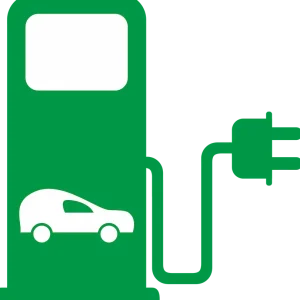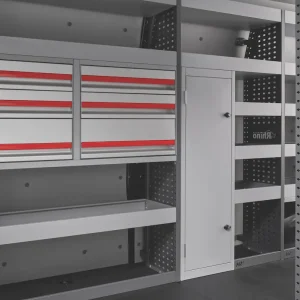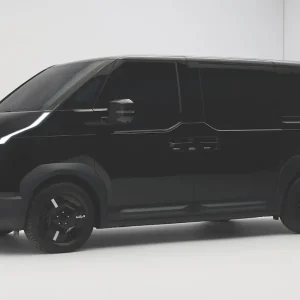The UK is the biggest market in Europe for pick-up trucks and by quite a distance.
More than 50,000 were registered last year with the Ford Ranger comfortably leading the pack. The popularity of pick-up trucks also shows no sign of abating with new models being launched and updated, making the International Pick-Up Award (IPUA) 2020 an important part of the calendar.
The biennial award has previously recognised the Ford Ranger, Nissan Navara and the previous winner the Volkswagen Amarok V6 as the best pick-up trucks on the open market. Now the 2019 test sees revised models from Ford, Nissan, Renault, Mitsubishi and Toyota all vying for the crown over a gruelling two days of testing on- and off-road.
Ford Ranger (best all-rounder)
There’s a huge amount of expectation placed on the Ford Ranger as arguably the vehicle responsible for leading the new renaissance in luxurious, aggressive pick-up trucks that have seen their numbers swell over the past decade.
Relaunched in 2011 and facelifted in 2016, there’s now a third generation of vehicle with a downsized engine producing more power. The 2.2-litre has been replaced – for the time being the 3.2-litre five-cylinder will remain – in the main by a 2.0-litre, four-cylinder Ecoblue unit that is already used in the Transit Custom and large Transit van.
There’s also a new 10-speed automatic as well as the standard six-speed manual. Technology has taken another significant step forward with autonomous emergency braking with pedestrian detection, and the exterior has been redesigned to make it even more macho.
The big change is, of course, that engine, which is a twin-turbo 2.0-litre now producing 213hp and 500Nm of torque – an increase of 30Nm. Other changes for the Wildtrak version include new LED headlights as well as an ebony black interior, which is more modern.
There’s also the option of a 10-speed auto on the top power output, which is the gearbox of choice for the stunningly engineered Ranger Raptor.
Other features across the new Ranger include an EasyLift tailgate that apparently requires 70% less effort to close – it really does make a huge difference. Dampers have been retuned, and the anti-roll bar and suspension mounts have been relocated, which all adds up to a slightly better, less jittery ride.
It’s also a much more sophisticated vehicle to cover long miles in thanks to a more refined engine and an engine cover that has been stuffed with noise-absorbing foam to reduce penetration into the cabin. It’s a pretty comprehensive reworking even if the results on the inside and out haven’t led to a massively different appearance. Nevertheless, the Ranger feels more grown-up, more sophisticated and every bit a class-leader in comfort, style and now refinement. Off-road, the only limiting factor is its large proportions – over a mixed terrain of banks, hills, ruts, gravel, mud and asphalt it dealt with them all without any fuss.
Its hill-descent control, though noisy when activating the brakes, quickly and capably slows the vehicle on a descent and is one of a number of reassuring safety blankets. The Ranger is the newest vehicle in contention for the award, but it is also the best all-rounder and the one most tailored to the demands of UK buyers. It’s an intelligent upgrade to the already immensely successful 2016 Ranger and this will ensure it stays as the UK pick-up of choice for years to come.

 Mitsubishi has given its L200 model a tough-looking exterior makeover
Mitsubishi has given its L200 model a tough-looking exterior makeover
Mitsubishi L200 (best value for money)
(Continued from page 1) Mitsubishi has revamped the sixth-generation vehicle with a tough-looking exterior makeover and some improved driver safety systems. Its history, however, and the applications it is most often found in in the UK means it must not only look tough but be tough.
That’s why the new model has undergone more than 2,400 changes – not bad for what is, like the Ranger, essentially a facelift and new engine.
The most noticeable change is the new front that is every inch the archetypal macho pick-up. The major alteration is centred around the new headlight position, which is now 100mm higher. It sits a full 700mm from the ground, which not only helps strengthen the looks but more importantly improves visibility by bringing the lights above the wading-height depth. Side bodywork has also been redesigned and the rear end has undergone quite a transformation too, most noticeable is the new lighting cluster. Like the Ranger, the important and usable parts of the L200 remain completely unchanged.
Mechanically, there is a new six-speed automatic gearbox with high and low range, but there have also been improvements to the Super-Select 4WD system. It is now possible to select between specific terrain modes with Gravel, Mud & Snow, Sand and Rock settings.
Each of the modes alters the throttle response and traction systems to optimise the L200’s performance across the surfaces. The additional ratio on the automatic box is a welcome change that lowers both noise and fuel consumption while also improving the shifting smoothness. Bigger shock absorbers have been added to the rear suspension while the front end gets larger brakes that certainly get the job done.
The L200 has long been one of the rougher-riding vehicles in the segment with quite a bouncy rear-end but it is now much smoother. While far from perfect, it’s a big step forward over the current truck and one which puts it on a more even footing with its most obvious rivals the Nissan Navara and Toyota Hilux. Safety features have also been added, with a new 360° bird’s eye-view camera as well as blind spot warning detection system with lane-changing assist, forward collision prevention, brake assist and rear cross-traffic alert, which warns of any collision as you back out of a space.
Off-road it’s a tireless workhorse of a machine and its smaller width and shorter body make it much more manoeuvrable than the Ranger. Its new hill-descent control system works differently to other manufacturers’ in that it will maintain the speed of your descent at whatever speed you are doing (providing it is less than 12mph). It is quick to react, smooth and very capable. It’s possibly the most accomplished in the business.
Then there’s the new engine, a new 2.3-litre turbodiesel producing 150hp and 400Nm that Mitsubishi says has similar performance to its old 2.5-litre unit. It’s based on the Outlander and ASX unit and as a result is a lot less agricultural than the outgoing model’s engine. It’s a huge step forward and when combined with the re-contoured front seats, which significantly improve comfort, and the new six-leaf rear springs (up from five), you can feel a real and significant sense of improvement in this new L200.


The latest Navara includes revisions to the rear suspension set-up
Nissan Navara (best for the road)
(Continued from page 2) By its own account, Nissan advanced the sector in 2015 when it launched its latest version of the Nissan Navara, and to its credit that year the brand won the International Pick-Up Award.
The new Navara, which is also sold as the Renault Alaskan in continental Europe, was and still is a very significant vehicle in the pick-up world, but despite the addition of a coil-sprung rear suspension to the otherwise work-focused Navara, no other manufacturers followed suit. The Navara, and its off-shoots, the Renault Alaskan and Mercedes-Benz X-Class, are alone in offering a ‘passenger car’ rear suspension, but that doesn’t make it the wrong decision.
This latest update includes revisions to that rear suspension set-up with dual-stage five-link coils that see the rear suspension height increase by 25mm. It also has an increased payload of 1,100kg as well as larger front brakes (now 320mm, up from 296mm) and rear disk brakes rather than drum. The engine remains the same 2.3-litre but the compression ratio has been reduced and there is now only a twin-turbo.
Other changes include steel and diamond-like carbon coated pistons rather than aluminium as well as increased injection pressure. It’s a techy update to a vehicle that is still at the forefront of the sector for its performance, comfort and abilities. Nissan says the pick-up sector should be more than just tough, which is why the king-cab version now comes with a coil-spring rear suspension, but more importantly for the Navara as a whole this latest update now includes an 8in touchscreen (up from 7in) that enables Apple CarPlay and Android Auto.
This keeps it on level terms with the Ranger and the L200 and helps reinforce that premium feel that begins with the best-in-class ride comfort – thanks to the suspension. There’s also a new manual six-speed gearbox that feels more attached to the driveline as a whole, and while the seven-speed auto remains it has been adapted to better match it to the throttle and engine. There’s no doubting the Navara is the best-riding vehicle in the sector when it comes to on-road performance, but it also manages to translate that ability into the off-road world where there is no noticeable loss of abilities.
Rather than the mechanical elements being the vehicle’s greatest weakness it is its technical application of some of the features like hill-descent control that show it is no longer the spring chicken it once was. Despite not being the definitive test for an off-roader each of the vehicle’s own abilities to deal with a steep incline proved to be an obvious and interesting differentiator between them, and the Navara felt the least comfortable tackling the obstacle. Despite that, on soft ground as well as bumpy surfaces, it effortlessly glided about. T
he new updates improve upon an already solid foundation with its new Euro6d-compliant engine in either 163hp or 188hp power ratings still proving to be a strong and economical match with a claimed 6.5% improvement in fuel consumption for manual vehicles and 3% improvement for those with auto gearboxes. Like its new intelligent trailer sway system, the upgrade is an intelligent evolution of an already impressive vehicle.



Of the vehicles here, the Hilux feels most at home over the off-road course
Toyota Hilux (best off-road)
(Continued from page 3) A previous update to the Toyota Hilux that saw it arrive in Europe in time for the 2018 award means that the changes to the most recently revised Hilux are on the face of it less impressive than the competition – however, that doesn’t mean the Hilux is at a disadvantage.
Its updates for now are confined to a raft of new safety equipment that includes autonomous braking, adaptive cruise control, lane departure warning with corrective braking, and road sign-assist. There are also minor tweaks to the exterior with a new grey look possible on the range-topping Invincible X models.
Power comes from a 2.4-litre diesel engine that not only produces more power (148hp) than the previous 2.5-litre unit but also more torque than the 3.0-litre lump that was also removed from the range at the time. Toyota also upgraded the chassis strength and added 100mm larger leaf springs to help give a smoother ride.
Of all the vehicles in contention, it is the Hilux that feels most at home over the off-road course. The toughness Hilux trucks are famed for really does impart a feeling of security and capability. Nothing seems to phase it or its four-wheel drive system and it flies over every obstacle with a minimum of fuss.
On the road, the Hilux is also a match for the refined Ranger and doesn’t disappoint when compared to the excellent ride quality of the Nissan.
It’s a highly impressive all-round package and makes the Hilux’s position as the second best-selling pick-up truck in Europe an understandable one. It is probably not as complete a package as the Ranger, but the Hilux, along with the Mitsubishi L200, really shows how decades of experience can produce a truly excellent pick-up that is capable of working in all manner of terrains.

Summing up
With such a strong line-up of competitors, picking a winner of the International Pick-Up Award is no easy task. The Nissan Navara is a former winner and has the best on-road driving manners of any of the contenders thanks to its multi-link rear suspension.
Toyota’s Hilux is not only a greatly improved version of the immensely popular truck, it is also arguably the best off-road performer of the group.
Then there are the two we would consider “all rounders” that, for the UK at least, are usually poles apart when it comes to what people buy.
Although the Mitsubishi L200 is available with all the gadgets and refinement you’ll find on a top-spec truck, it’s still not pushed itself into the same category as the Ford Ranger, which is not only the best-selling pick-up in the UK but also one of the ones most frequently bought as a top-spec model. Both are comfortable on-road and capable off-road but attract a different set of customers and operate at different price points.
As the two newest vehicles, both entering the market this year, they are arguably the ones to watch, but the differing requirements of the countries represented by the judges means that this is no forgone conclusion or even a two-way fight.
While the UK market’s ever-increasing demand for bigger, brasher, more car-like pick-ups must come into consideration when What Van? awards its point scores, other countries have far more utilitarian expectations of their pick-up trucks, and just because something is new and shiny won’t necessarily mean it will triumph.
Find out the winner of the International Pick-Up Award in What Van? as well as the winner of the International Van of the Year award.
Comment: Luxury added to true grit
The interesting part of testing so many pick-up trucks at once is taking a moment to stand back and realise just how fast the sector is evolving.
When I first got behind the wheel of a pick-up truck – a late Eighties-registered Hilux (the particularly square-looking kind that looking back reminds me of a cassette tape from around the same era) – it was a rough agricultural experience.
I vividly remember having to use two hands to yank the transfer box into four-wheel drive and can still picture the cracked windscreen, inch-thick mud-coated floor and dusty cloth seats.
Unquestionably tough – by the time I drove it, it had covered tens of thousands of miles on a commercial farm with no love or sympathy paid towards it – the Hilux I remember seems almost unrelated to the ‘same’ vehicles of three decades later, which are changing so fast that even a three-year-old model now feels old-hat. It seems hard to imagine these vehicles ever getting into such a dilapidated state as the first one I drove – although I’m sure they are more than capable of surviving the abuse – as the market has taken such a turn towards luxury.
Instead, it now feels just as important to judge these trucks based on their comfort, quality and desirability as it is their workhorse-like capabilities and durability.
George Barrow is the UK judge for the International Van of the Year, the prestigious prize awarded by leading European LCV journalists.
What is the IPUA?
Like the International Van of the Year award, the International Pick-Up Award (IPUA) is chosen by a panel of respected journalists from across Europe.
Unlike the van award, which is annual with judging taking place throughout the year, the IPUA is biennial, and just before the voting deadline gathers together the most recently launched models for several days of thorough evaluation.
Any pick-up launched since the last award was announced is eligible and manufacturers are free to bring whatever model they think appropriate. The vehicles are driven on- and off-road, measured and evaluated, and put through a fuel-comparison evaluation.
Like the van award, joint-engineered products are judged together, unless there is sufficient reason to consider them separately – which in this case means the Navara and Alaskan are evaluated separately but scored as a single contender. Jury members can award a maximum of seven points to any one vehicle with a total of 12 points in their allocation – however, not all points have to be awarded. The winner will be announced at the Solutrans Commercial Vehicle Show on 20 November.
Sponsored by:






